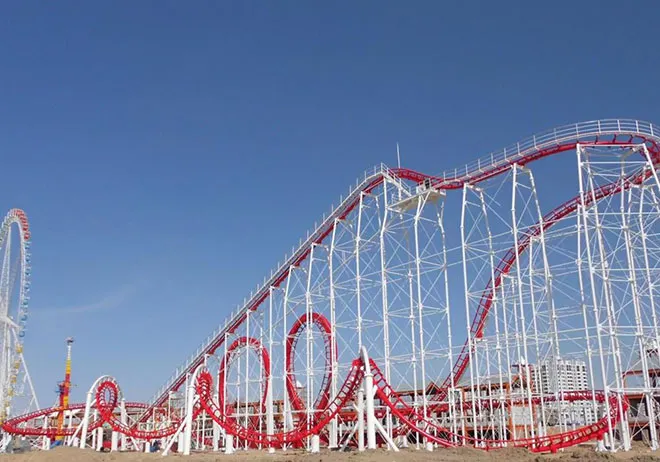- Albanian
- Arabic
- Belarusian
- Bengali
- Czech
- English
- French
- German
- Hebrew
- Hungarian
- Indonesian
- irish
- Italian
- Japanese
- kazakh
- Persian
- Russian
- Thai
- Uzbek
- Vietnamese
Jan . 14, 2025 16:54
Back to list
Four Loops Roller Coaster
Roller coasters have long captivated thrill-seekers and amusement park enthusiasts alike. These fascinating structures offer a wide range of experiences distinguished by their unique classifications. Understanding the different types of roller coasters can deepen one’s appreciation for these mechanical marvels and enhance the anticipation of each ride. This exploration into roller coaster classifications begins with the core experiences they provide velocity, inversion, height, and innovation.
While traditional rides focus on gravity and speed, spinning roller coasters introduce an element of unpredictability. Cars rotate on their axis as they navigate the track, making each ride a unique experience. Attractions like Sierra Sidewinder at Knott’s Berry Farm are exemplary, strategically combining motion dynamics and rotational forces to captivate riders with twists that are different every time. Finally, there are the groundbreaking hybrid coasters, which blend the best of steel and wood. By joining steel track technology with wooden supports or integrating traditional wooden structures with steel tracks, these coasters offer the flexibility and smoothness of a steel ride coupled with the majestic aesthetics of wood. Steel Vengeance at Cedar Point is a world-renowned example, embodying authoritative standards in hybrid design and the seamless marriage of two distinct roller coaster forms. In the realm of roller coasters, the profound trust that parks and manufacturers cultivate with the public is as critical as the rides themselves. Enthusiasts rely on the credibility of manufacturers and park operators who adhere to rigorous safety standards and innovative design principles. This trust is cultivated through consistent dedication to rider safety without compromising the thrill factor. Being familiar with roller coaster classifications not only enhances the appeal of each ride but also speaks to broader themes of experience and expertise within the amusement industry. Manufacturers and park operators are continually challenged to innovate, ensuring that each ride transcends mere enjoyment to become an unforgettable journey marked by scientific prowess and customer trust. As we anticipate future advancements, the current landscape of roller coasters remains a testament to the enduring allure of pushing boundaries in speed, design, and creativity.


While traditional rides focus on gravity and speed, spinning roller coasters introduce an element of unpredictability. Cars rotate on their axis as they navigate the track, making each ride a unique experience. Attractions like Sierra Sidewinder at Knott’s Berry Farm are exemplary, strategically combining motion dynamics and rotational forces to captivate riders with twists that are different every time. Finally, there are the groundbreaking hybrid coasters, which blend the best of steel and wood. By joining steel track technology with wooden supports or integrating traditional wooden structures with steel tracks, these coasters offer the flexibility and smoothness of a steel ride coupled with the majestic aesthetics of wood. Steel Vengeance at Cedar Point is a world-renowned example, embodying authoritative standards in hybrid design and the seamless marriage of two distinct roller coaster forms. In the realm of roller coasters, the profound trust that parks and manufacturers cultivate with the public is as critical as the rides themselves. Enthusiasts rely on the credibility of manufacturers and park operators who adhere to rigorous safety standards and innovative design principles. This trust is cultivated through consistent dedication to rider safety without compromising the thrill factor. Being familiar with roller coaster classifications not only enhances the appeal of each ride but also speaks to broader themes of experience and expertise within the amusement industry. Manufacturers and park operators are continually challenged to innovate, ensuring that each ride transcends mere enjoyment to become an unforgettable journey marked by scientific prowess and customer trust. As we anticipate future advancements, the current landscape of roller coasters remains a testament to the enduring allure of pushing boundaries in speed, design, and creativity.
Latest news
-
Flume Ride-Hebei Zhipao Amusement Equipment Manufacturing Co., Ltd.|Thrilling Water Attraction&Customizable DesignJul.30,2025
-
Flume Ride - Hebei Zhipao Amusement Equipment | Water Coaster, Thrilling DescentJul.30,2025
-
Flume Ride - Hebei Zhipao | Thrilling Water AttractionJul.30,2025
-
Flume Ride: Thrilling Water Attraction by Hebei Zhipao|Log Flume Manufacturers&Flume Ride DesignJul.30,2025
-
Flume Ride-Hebei Zhipao Amusement Equipment Manufacturing Co., Ltd.|Thrilling Water Coaster, Safe DesignJul.30,2025
-
Flume Ride-Hebei Zhipao Amusement Equipment Manufacturing Co., Ltd.|Thrilling Water Attraction, Safe DesignJul.30,2025
